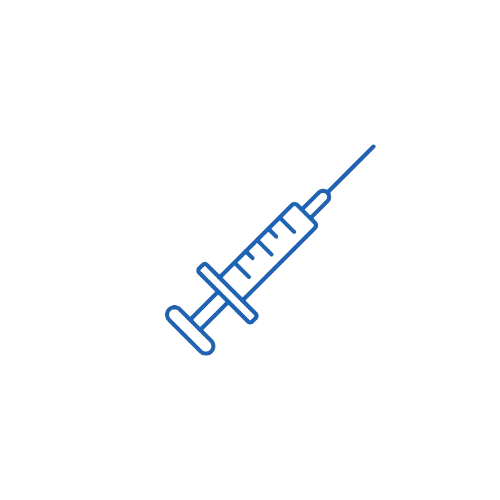Filgrastim
Medicines List
All MedicineIndications
Approved Indications:
- Chemotherapy-Induced Neutropenia
For reducing the duration of severe neutropenia and risk of infection in patients receiving myelosuppressive chemotherapy for non-myeloid malignancies. - Bone Marrow Transplantation (BMT)
To reduce the duration of neutropenia in patients undergoing myeloablative chemotherapy followed by bone marrow transplantation. - Peripheral Blood Progenitor Cell (PBPC) Mobilization
To mobilize hematopoietic progenitor cells into peripheral blood for collection and subsequent autologous or allogeneic transplantation. - Severe Chronic Neutropenia (SCN)
For the treatment of congenital, cyclic, or idiopathic neutropenia to increase neutrophil counts and reduce infection incidence. - Acute Myeloid Leukemia (AML)
To reduce neutropenia duration following induction or consolidation chemotherapy in AML. - Radiation-Induced Myelosuppression (Hematopoietic Syndrome of Acute Radiation Syndrome)
Approved to enhance survival following high-dose radiation exposure affecting bone marrow.
Clinically Accepted Off-Label Uses:
- HIV-Associated Neutropenia
- Myelodysplastic Syndrome (MDS)-Related Neutropenia
- Aplastic Anemia (as adjunct to immunosuppressive therapy)
- Neutropenia in Chronic Hepatitis C Patients Treated with Interferon
- Stem Cell Donor Priming in Healthy Volunteers for Allogeneic Transplantation
Dosage & Administration
Route of Administration: Subcutaneous (SC) or Intravenous (IV) infusion
Adults:
- Chemotherapy-Induced Neutropenia:
5 mcg/kg/day SC or IV, starting 24–72 hours after chemotherapy and continuing until ANC recovery (up to 14 days). - BMT:
10 mcg/kg/day IV as continuous infusion or in divided doses, starting ≥24 hours after transplantation until ANC recovery. - PBPC Mobilization:
10 mcg/kg/day SC for 4–5 days. Leukapheresis typically starts on Day 5. - SCN (Congenital/Cyclic/Idiopathic):
Initial dose: - Congenital: 6 mcg/kg SC twice daily
- Cyclic/Idiopathic: 5 mcg/kg SC once daily
Adjust individually based on ANC response. - AML (Post-Chemotherapy Recovery):
5–10 mcg/kg/day SC or IV until post-nadir ANC recovery. - Radiation Exposure:
10 mcg/kg SC daily as soon as possible after exposure. Continue for up to 21 days or until ANC ≥1,000/mm³ for 3 consecutive days.
Pediatrics:
- Dosing is weight-based and mirrors adult recommendations (5–10 mcg/kg/day) for neutropenia and stem cell mobilization. Monitor ANC closely.
Elderly:
- No specific dose adjustment required. Monitor response and tolerability.
Renal/Hepatic Impairment:
- No dosage adjustment necessary. Monitor ANC routinely.
Mechanism of Action (MOA)
Filgrastim is a recombinant form of human granulocyte colony-stimulating factor (G-CSF) that specifically binds to G-CSF receptors on hematopoietic cells. This stimulates proliferation, differentiation, and activation of neutrophil precursors in the bone marrow. Through JAK/STAT, PI3K, and MAPK signaling pathways, filgrastim enhances the survival and functional activity of neutrophils, accelerating their recovery after cytotoxic therapy or bone marrow damage, thereby reducing infection risk and improving immune function.
Pharmacokinetics
- Absorption: Rapid after SC administration; peak levels within 2–8 hours.
- Bioavailability (SC): ~62%
- Distribution: Volume of distribution ≈ 150 mL/kg
- Metabolism: Not metabolized hepatically; degraded by neutrophils and macrophages
- Half-life: 3.5 hours (SC); prolonged in neutropenic states
- Elimination: Renal clearance and cellular degradation
- Onset of Effect: Increase in ANC typically within 1–2 days
Pregnancy Category & Lactation
- Pregnancy:
Not assigned a formal FDA pregnancy category under new labeling regulations. Animal studies show no teratogenicity, but human data are limited. Should only be used if potential benefit justifies potential risk. - Lactation:
Unknown if excreted in breast milk. Limited human data suggest minimal transfer and no adverse effects in breastfed infants. Use with caution. - Recommendation:
Use only when clearly indicated in pregnancy and breastfeeding. Monitor infant if lactating mother is treated.
Therapeutic Class
- Primary Class: Hematopoietic Growth Factor
- Subclass: Recombinant Human Granulocyte Colony-Stimulating Factor (rhG-CSF)
Contraindications
- Known hypersensitivity to filgrastim or E. coli-derived proteins
- History of serious allergic reactions to filgrastim or similar agents (pegfilgrastim, lenograstim)
- Patients with severe sickle cell disease (risk of crisis)
- Do not use within 24 hours before or after chemotherapy
Warnings & Precautions
- Splenic Rupture:
Rare but potentially fatal. Monitor for left upper abdominal or shoulder pain. - Acute Respiratory Distress Syndrome (ARDS):
Reported in neutropenic patients receiving filgrastim. Discontinue if symptoms occur. - Allergic Reactions:
Anaphylaxis and severe allergic events have been observed. Immediate discontinuation required if suspected. - Sickle Cell Disease:
Use with extreme caution; filgrastim may trigger sickle cell crisis. - Leukocytosis:
High WBC counts may occur. Monitor CBC twice weekly during treatment. - Capillary Leak Syndrome:
Rare; presents with edema, hypotension, and hemoconcentration. - Long-Term Use in SCN:
Risk of myelodysplastic syndrome (MDS) or acute myeloid leukemia (AML); long-term monitoring is essential.
Side Effects
Common (≥10%):
- Musculoskeletal: Bone pain, back pain
- General: Fever, fatigue, injection site erythema
- Hematologic: Leukocytosis, mild thrombocytopenia
- Gastrointestinal: Nausea, vomiting
Uncommon (1–10%):
- Headache, rash, chest pain, cough, dizziness
Serious/Rare (<1%):
- Splenic rupture
- ARDS
- Capillary leak syndrome
- Sickle cell crisis
- Hypersensitivity/anaphylaxis
- MDS/AML in long-term SCN treatment
Drug Interactions
- Chemotherapy Agents:
Avoid administering filgrastim 24 hours before or after chemotherapy due to risk of enhanced myelosuppression. - Lithium:
May increase neutrophil production; monitor closely if used together. - Corticosteroids:
May enhance leukocytosis when co-administered. - Food and Alcohol:
No significant interactions known. - Metabolism/Enzymes:
Not metabolized via CYP450 enzymes; minimal CYP-mediated interaction potential.
Recent Updates or Guidelines
- FDA Update (Radiation Exposure):
Filgrastim approved for use in hematopoietic syndrome of acute radiation exposure, improving emergency preparedness for mass radiation events. - Biosimilar Access Expanded:
Multiple filgrastim biosimilars (e.g., Zarxio, Nivestim) approved in various regions, offering cost-effective alternatives. - Guideline Updates (ASCO, ESMO):
Recommend filgrastim as standard prophylaxis in patients with high-risk chemotherapy regimens or previous neutropenic complications.
Storage Conditions
- Temperature: Store between 2°C to 8°C (refrigerated).
- Do Not Freeze: Freezing denatures the protein and renders it inactive.
- Protection from Light: Keep in original outer carton to avoid light exposure.
- Handling: Do not shake. Shake-induced foam may damage protein integrity.
- Room Temperature Allowance: May be stored at up to 25°C for a single period of 24 hours. Discard if not used within this time.
